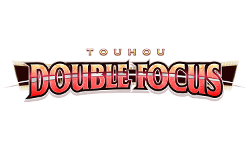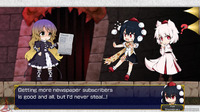|
|

|
PLATFORM
|
PS4
|
BATTLE SYSTEM
|

|
INTERACTION
|

|
ORIGINALITY
|

|
STORY
|

|
MUSIC & SOUND
|

|
VISUALS
|

|
CHALLENGE
|
Hard
|
COMPLETION TIME
|
Less than 20 Hours
|
|
OVERALL

|
+ Challenging yet fair
+ Charming art
+ Has Touhou characters
- Short and linear
- Excuse of a plot
|
Click here for scoring definitions
|
|
|
Indie developer AQUA STYLE seems to have made it its mission to bring Touhou to as many disparate genres as possible. Touhou Double Focus is quite simply a Metroidvania with a Touhou skin. It's a short and simple game with no major flaws, but also not much to recommend it. It serves as an enjoyable enough distraction for a couple of hours, and seems designed to court speedrunners, but unless your goal is to play every indie Metroidvania ever released there are probably better options.
Once again, the setting is Gensokyo, a small region in the mountains of Japan filled with ancient gods and yokai. Our protagonist this time is an unethical journalist named Aya who's not above embellishing the facts to get the next big scoop, and happens to be a tengu. Tengu are known for their arrogance, and Aya isn't exactly one to buck stereotypes. Fearless to a fault, she inadvertently opens up a sealed magical book that traps the residents of Gensokyo in a strange land filledd with generic video game levels like "castle" and "desert". The book also seals away all but the most basic of her abilities, most notably removing her ability to fly. Unperturbed, she immediately sets about exploring this new land in hopes of getting an article out of it, and maybe rescuing everyone trapped inside if she can spare the time. Joining her is her begrudging assistant Momiji, who generally acts as the more reasonable one for Aya to bounce off of.
The gameplay is just what one would expect from a 2D Metroidvania: some basic platforming, new abilities that unlock new areas to explore, and boss fights every now and then. The closest thing the game has to a gimmick is the ability to switch between the two playable characters at any time. Aya is a crow tengu who specializes in mid-range attacks with wind magic or her camera. She can also air-dash, hover, and dodge through attacks. Momiji is a wolf tengu with a more classic sword and shield fighting style, who can block enemy attacks and climb walls. Both can perform all the basic platforming, and both have advantages against different opponents. While they share a health bar, each character has a separate stamina bar which quickly recovers but limits their ability to attack or block consecutively. Experts may find it useful to switch between them constantly to get the most value out of their stamina, although this isn't at all necessary on the Normal difficulty. As the two tengu explore the dungeons, they will also find skill books that unlock more of their original abilities. These abilities take up slots on the characters' skill bars, and even passive abilities must be equipped. While multiple skill sets may be equipped at once and quickly swapped through with the shoulder buttons, it can get annoying to quickly find the right skill in the heat of battle. With two characters and three sets each, that can be a lot of swapping.
 Inside the armor are three fairies standing on each other's shoulders.
Inside the armor are three fairies standing on each other's shoulders.
|
|
The gameplay is difficult but fair. The controls are responsive, and it feels like the player's fault when they die. Enemy attacks will usually deal a huge percentage of Aya's health bar, but it's also easy to dodge them with a bit of practice. This is the kind of game where the player is expected to die often as they get used to a new area or boss fight, but it never feels like there's an impassable wall. The game is also fairly generous with healing items, which can be stocked up and saved for later.
While each individual area of the book has a lot of variety and route splits, overall progression through the game is quite linear. The boss of one area always provides an ability that allows access to the next area, and there doesn't seem to be much room for sequence breaking. The most stand-out feature of the game is the way it handles save points. Instead of finding save rooms scattered throughout the levels, Aya finds portal books that can be used anywhere to create a permanent portal back to the central save hub. Being able to place a portal directly before a boss fight or a difficult section really helps to make them less frustrating. However, there are a limited number of these items throughout the game, so choosing good locations is essential. Poor placement will lead to unnecessarily long walks or possibly getting hit in the head by falling rocks every single time you warp there.
Scattered throughout the dungeons are also a variety of NPCs, who invariably have fetch quests for Aya. Some of these quests are necessary to advance, but most simply teach situational skills that the player may never even use. That said, 100% completion offers a slightly different ending, and none of the quests are especially annoying. Naturally, every single NPC is a popular Touhou character and their personalities are colorful enough for their brief screentime. The game doesn't usually expect the player to be familiar with these characters, although there's one quest that relies on the player remembering that one character's special power is to read ancient writing, which didn't seem to be made obvious by the story. The story itself is obviously just an excuse for the gameplay: it's the kind of thing where everything goes back to normal at the end and no one learns any lessons.
 A tengu never lies unless it's really convenient to.
A tengu never lies unless it's really convenient to.
|
|
It's worth noting that the game is built with speedrunning in mind. It can easily be completed in just a few hours on a blind run, and for a practiced player under an hour seems very possible. There's even a built-in time-attack mode that skips all cutscenes and has an on-screen timer. While these are certainly convenient features for anyone planning a speedrun, it seems unlikely that any sort of community will form around a niche game like this. For everyone else though, the main takeaway is that it's an extremely short game that doesn't provide all that much satisfaction for completing only once.
The graphics are uniformly charming. The opening and ending cutscenes take a rough, storybook approach, while the in-game sprites are smooth and attractive. Even the enemies are all cute little fairies playing dress-up as knights or cute antlions. The environments are as cliché as it gets, but do their job. The music is more or less forgettable, but Touhou fans will appreciate that the proper character themes are used for boss fights. Voice acting is available only in Japanese, and is relatively sparse. The only fully voiced scenes are the opening and ending, as well as little skits in the enemy compendium where Aya and Momiji comment on anyone who they've taken a picture of. In gameplay, you'll only hear the playable characters shouting as they attack and such. The acting itself is unexceptional, but can lean towards being annoying during certain repetitive actions like switching between the characters rapidly.
Touhou Double Focus is a Touhou Metroidvania. It's honestly hard to describe it any better than that. If that doesn't sound like something you absolutely must buy, then you probably shouldn't. If either of those words provokes a strange compulsion in you though, it's a charming game that's enjoyable to play for its incredibly brief duration.
Review Archives
|









